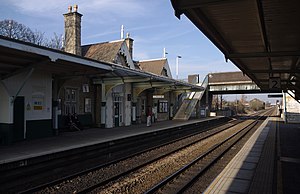|
Beeston railway station
Beeston railway station serves the town of Beeston in Nottinghamshire, England. It lies on a spur of the Midland Main Line and is managed by East Midlands Railway. It is situated 3.2 miles (5.1 km) south-west of Nottingham railway station and 750 metres (0.5 mi) south-east of Beeston transport interchange, for local bus services and Nottingham Express Transit trams. The station building is Grade II listed.[1] DescriptionBeeston station is a stop on the Midland Main Line; it is located 123 miles 22 chains (198.4 km) from London St Pancras, on a spur towards Nottingham.[2] There are two platforms: platform 1 to the north for trains towards Nottingham and Lincoln; and platform 2 to the south for trains towards London, Leicester, Birmingham and Derby. The platforms may be accessed either by steps from the Station Road bridge, or by short ramps from Station Road for platform 1 or Technology Drive for platform 2. History19th century The station was built in 1839 for the Midland Counties Railway;[3][page needed] services began on 4 June 1839. In 1844, the Midland Counties Railway joined with the North Midland Railway and the Birmingham and Derby Junction Railway to form the Midland Railway. The original station building, which was little more than a cottage, was replaced in 1847 with the substantially larger white brick building with ashlar trimmings which still exists. This is notable for its carved bargeboards, some remaining diagonal paned windows and the pseudo-heraldic shields with 'MR' and '1847'.[4][page needed] The wooden platform canopies and adjacent wrought-iron and glass canopy were installed in 1871. The wooden platform canopies were originally located at Southwell railway station, and were relocated to Beeston when Southwell was rebuilt.[5][page needed] The growth of Beeston led to substantial expansion of the station facilities in the Edwardian period. An extension containing a large booking hall, ladies' waiting room and parcels office was added to the rear of the station building, doubling its floorspace. 20th century In 1937, the Midland Railway drew up plans for an additional waiting room on platform 2, but the plan was never put into action. The level crossing, lattice footbridge and signal box survived until 1969, when Beeston and Stapleford Urban District Council built a road bridge (Station Bridge) across the railway to ease traffic delays caused by the frequent closure of the level crossing. This effectively replaced the footbridge between the two platforms.  With the decline in passenger numbers in the 1980s, the entire station suffered from vandalism and neglect; British Rail proposed complete demolition. A spirited campaign by the local civic society and rail historians led to the listing of the station building in 1987. A separate listing application was made in the early 1990s and the platform shelters were also listed. This was followed by restoration of what remained of the 1847 building and the platform shelters. The (architecturally undistinguished) extension was demolished, revealing the original gables on the north side of the building. 21st centuryThe original platform masonry survived until 2004, when the platforms were completely rebuilt.
Nottingham remodelling schemeBetween 20 July and 25 August 2013, the services from the station were reduced because of the Nottingham remodelling and resignalling scheme.[6] It acted as a terminus for trains from London, via East Midlands Parkway, and from Derby, with a frequent rail-replacement shuttle bus running to and from Nottingham while the western end of the station and approach lines were remodelled. Beeston station staffStation Masters
1881 censusThe railway employed a large number of local people. The 1881 census for Beeston[19] shows 141 men with railway employment, although there is no evidence that they all worked in Beeston. MiscellaneousIn 1864, John Ashe is listed as the booking clerk. Leslie Blood worked in the booking office from 1926 to 1939, when he was promoted to the position of Stationmaster at Stoke Golding. Sir Neil Cossons, now Chairman of English Heritage, worked as a junior porter in his youth. Facilities The station is managed by East Midlands Railway. Passenger numbers using the station have risen substantially in recent years; facilities include a ticket office, ticket vending machines, a café, bicycle racks, car parking and a taxi rank.[20] The Derby-Nottingham section of Route 6 of the National Cycle Network passes by the station and provides a traffic-free cycle route to the University of Nottingham. The Victoria Hotel public house is adjacent to the Nottingham-bound platform and has its own gate access to the platform, for which it reputedly pays an annual peppercorn rent of 50 pence. The gate was locked out of use for a number of years, so access to the Victoria Hotel was via Technology Drive or Barton St; however, it was opened for access again in 2014. Network Rail have a long-term aspiration to extend both platforms by up to 69 metres.[21] In January 2024, Network Rail started work on a nine month project to add new lifts, allowing direct step-free access between the two platforms.[22][23] Services Services at Beeston are provided by two train operating companies:

Station Master's House The first station master's house was built in 1839 as a small cabin. It was replaced by a larger building, which was originally at Southwell; it was moved to Beeston and erected in 1857. The house, at 211 Station Road, is now private property in use as Station House Children's Day Nursery. See alsoReferences
External linksWikimedia Commons has media related to Beeston railway station.
|
|||||||||||||||||||||||||||||||||||||||||||||||||||||||||||||||||||||||||||||||||||||||||||||||||||||||||||||||||||||||||||||||||||||||||||||






